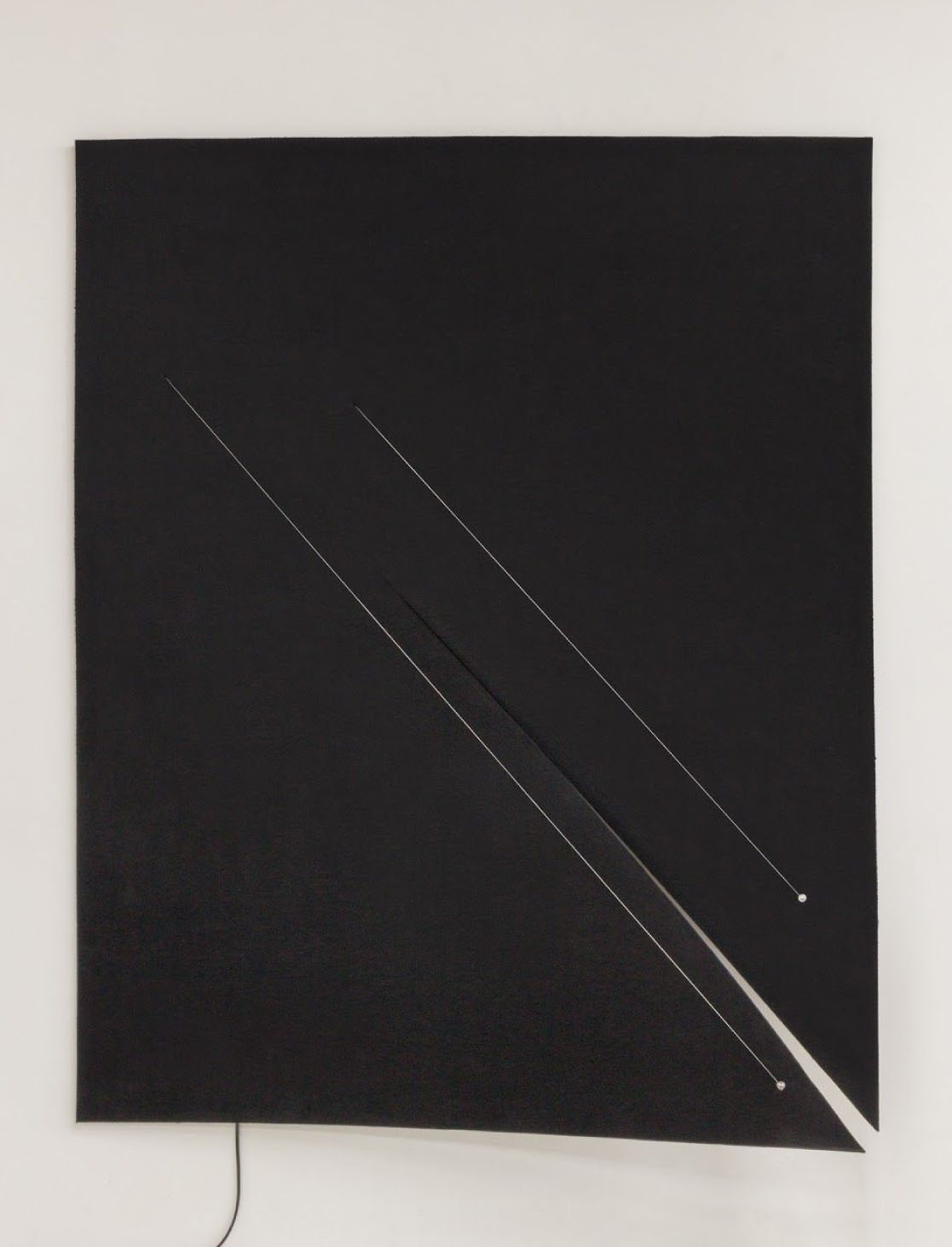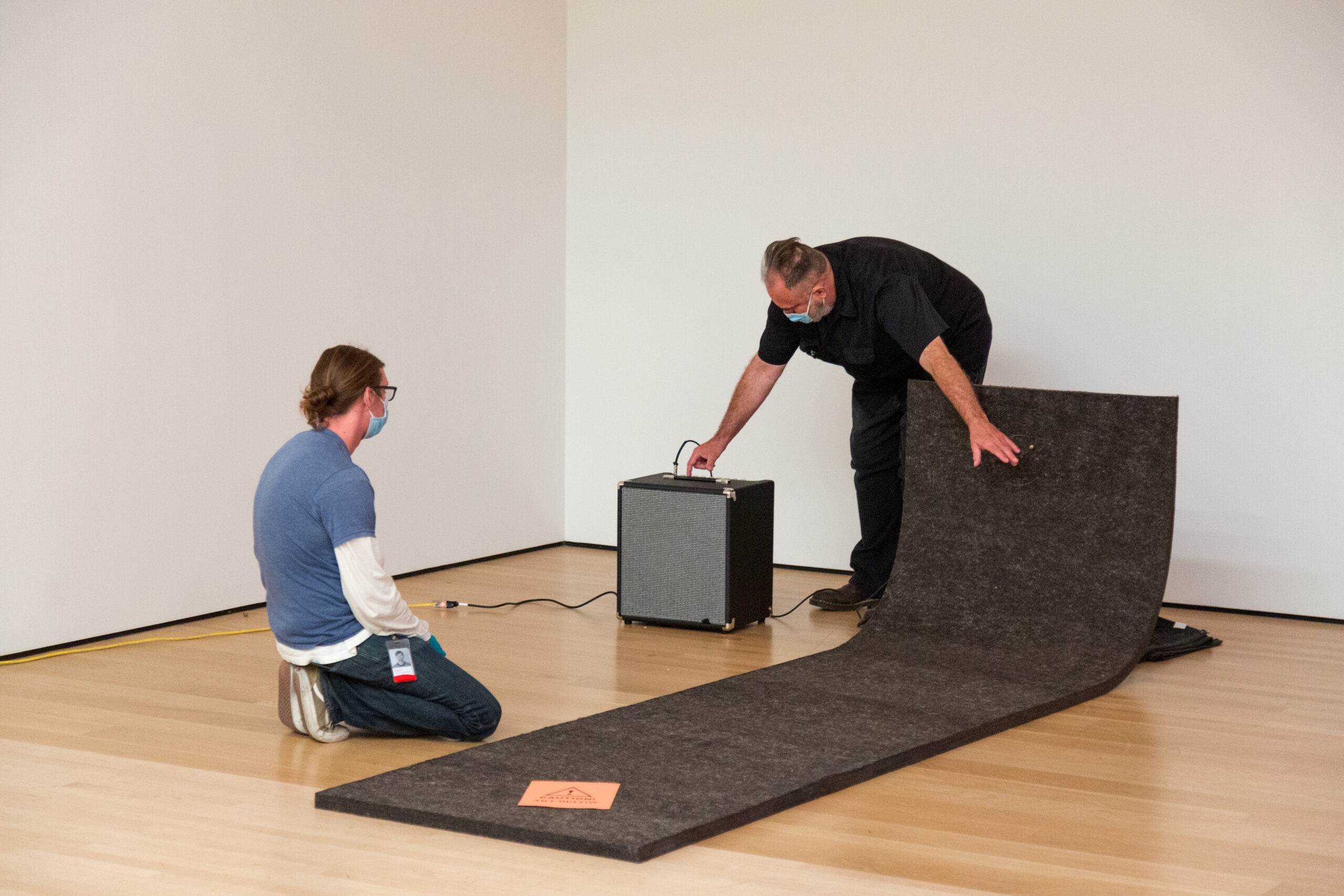Art has no boundaries beyond what an artist can conjure, but materials often have limits. Paint can flake, fabrics can fray, and plastic can degrade, requiring maintenance and conservation. Complex works may demand special handling with every presentation to confirm if technology is still operational or that all pieces of a work are intact. In many cases, the journey of a work from a curator’s exhibition wish list to the walls of SFMOMA requires what we call a “study day.”
A study day offers curators and art installation staff the chance to see the work in person, understand how best to steward its care, and decide on its display. This article spotlights the study days for Yoko Ono’s MEND PIECE, San Francisco Museum of Modern Art version (1966/2021) and Naama Tsabar’s Work on Felt (Variation 2) (2019) and Work on Felt (Variation 11) (2019). These works will be featured in What Matters: A Proposition in Eight Rooms, opening July 22, 2023, an exhibition that presents contemporary works from the collection.
What Matters?
Unfolding in multiple stages, What Matters is a wide-ranging contemporary collection exhibition jointly organized by SFMOMA curators across architecture and design, contemporary art, media arts, painting and sculpture, and photography. Curators will take turns designing episodes of this exhibition and contributing fresh selections at switchover points.
“The phrase ‘what matters’ is intended as a prompt for different experiences in this exhibition,” explains Curator of Media Arts Rudolf Frieling, who is overseeing this first episode with Curator of Contemporary Art Eungie Joo. And what matters can vary wildly.

Study day for Yoko Ono’s MEND PIECE, San Francisco Museum of Modern Art version, 1966/2021; photo: Don Ross
With Yoko Ono’s MEND PIECE, San Francisco Museum of Modern Art version (1966/2021), visitors are invited to sit at a table to mend broken ceramic cups and saucers, coming together, in Ono’s words, to “mend the earth.” Meanwhile, the wool, felt, and piano strings in Tsabar’s Work on Felt (Variation 2) and Work on Felt (Variation 11) activate the literal “matter,” or material, in soft yet rigid sculptures that double as musical instruments.
Continuing ideas of care, Matthew Barney’s Drawing Restraint #14 (2006), a site-specific installation created for SFMOMA, investigates the idea that form emerges through struggle against resistance. Changes to the museum’s building over the last decade have hindered display of elements of the artwork. What Matters provides the opportunity to reintroduce several performance remnants and video documentation alongside the graphite drawing Barney produced on the wall above the Floor 4 window in the Evelyn and Walter Haas, Jr. Atrium.
Study Day for Yoko Ono’s MEND PIECE, San Francisco Museum of Modern Art version (1966/2021)
“Mend with wisdom, mend with love. It will mend the earth at the same time.” These instructions from Yoko Ono guide this potent installation where participants sit together at a table repairing broken ceramic cups, creating new configurations with glue, tape, scissors, and twine.

Study day for Yoko Ono’s MEND PIECE, San Francisco Museum of Modern Art version, 1966/2021; photo: Don Ross
As Frieling describes, “This idea of mending is a nod to the Japanese tradition of kintsugi, the art of repairing broken pottery using lacquer mixed with precious metals, such as gold and silver. It nurtures a break as an important part of an object’s history.” In the context of the provocation “what matters?”, it is also emblematic of the need to heal a broken world and how we might create something even more beautiful and precious in our process of mending — relevant to both the divisive time during which Ono produced the piece and today’s world.
The study day held in SFMOMA’s Conservation Studio replicated Ono’s installation meticulously, from the artist’s posted instructions to the white table, chairs, and shelf to display mended pieces. Curators and exhibition staff came prepared with questions on topics from optimal table and seating configuration and what kind of glue or thickness of string to provide participants, to more serious considerations such as the potential for injury from ceramic shards.

Museum staff preparing for study day for Yoko Ono’s MEND PIECE, San Francisco Museum of Modern Art version, 1966/2021; photo: Don Ross
Before the meeting, exhibition staff tested different methods to break the cups, which was a change from their typical duties. “We rarely are asked to intentionally break things,” says Museum Preparator Claire LaMont.
Over 40 SFMOMA staff across departments participated in the four-hour study period, offering their questions and feedback about the experience on sticky notes posted on whiteboards. Some commented on the feelings that arose from the process — “meditative,” “peaceful,” and “relaxing” — while others focused on practicalities — “provide stronger glue,” “stock Band-Aids,” and “children must be supervised.”

Study day for Yoko Ono’s MEND PIECE, San Francisco Museum of Modern Art version, 1966/2021; photo: Don Ross
Curatorial and installation staff left with many questions answered and others raised. Every piece of feedback gathered from the study day was considered to shape visitors’ experience of this participatory work at SFMOMA. For remaining questions, staff consulted both the artist’s studio and art venues that have previously presented the installation.
Experience Ono’s meditative installation on collective healing alongside fascinating works by other artists.
Study Day for Naama Tsabar’s Work on Felt (Variation 11) and Work on Felt (Variation 2)
Naama Tsabar’s Work on Felt (Variation 11) (2019) is a wall-mounted sculpture that can also be played as a musical instrument. Work on Felt (Variation 2) (2019), another piece from the same series, is a floor-based version. New to the collection, these sculptures continue SFMOMA’s exploration into sound-based media works, deepening the museum’s unique holdings in this vein.

Naama Tsabar, Work on Felt (variation 11), 2019; collection San Francisco Museum of Modern Art, jointly owned with Kadist, Paris/San Francisco; © Naama Tsabar
Each work, featuring a panel of thick wool felt strung with a piano string tuned to a predetermined tension, comes alive in activation, inviting full-body engagement, from drumming on and stroking the felt, to traditional bow work and string plucking. The resulting sounds — hypnotic, sonorous, even guttural — further raise the works’ emotional and psychological tensions.
Through periodic in-gallery performances by female-identifying or gender-nonconforming musicians stipulated by the artist, Tsabar threads gender and feminist considerations into the work. Visitors of all ages will also have the opportunity to play the instruments.
“The series Work on Felt resonates with the history of minimalism and post-minimalism, but also speaks very clearly to participation and performance,” Frieling says. “It’s not quite the playing of an instrument that we know, but it is a very personal and very embodied relationship to material and sound.”
For artworks like Work on Felt, which feature a sound component, and which will be handled by numerous performers and visitors, a study day is necessary to test the set up and performance of the works over time.

Study day for Naama Tsabar’s Work on Felt (variation 2); photo: Don Ross
To test the pieces, installation staff unpacked and inspected the artworks at SFMOMA’s Collection Center. They positioned the felt on the wall and on the ground to understand the material’s behavior (Will it curl easily? Will it lay flat automatically?) and its texture (Is it rough or soft? Will it withstand repeated use?). Maintenance and supervision are additional concerns for works that involve audience handling.

Study day for Naama Tsabar’s Work on Felt (variation 11); photo: Don Ross
Staff then followed the installation instructions, stringing the wire and testing the tuning of the pieces. They periodically played the sculptures over the course of days and found that the tension of the string was different after three days. “That immediately raised the question of whether we have to re-tune them each day,” says Frieling. “The artist said they should always have the exact same tension, so maybe they were not installed correctly when testing.”

Study day for Naama Tsabar’s Work on Felt (variation 2); photo: Don Ross

Study day for Naama Tsabar’s Work on Felt (variation 11); photo: Don Ross
In the case of complex artworks like the Work on Felt sculptures, which require set up to exact specifications, it’s important to produce an operational manual created in dialogue with the artist to guide their presentation now and in the future. As Frieling explains, “Artists often provide manuals when they run into the same questions repeatedly with a work. Other times we do not know what the important questions are until we interact with the piece, and we can then capture these experiences in a document.”
Open your senses and minds to new ideas, processes, and systems through What Matters and find prompts to explore what matters to you.
What Matters: A Proposition in Eight Rooms opens July 22, 2023 on Floor 4.